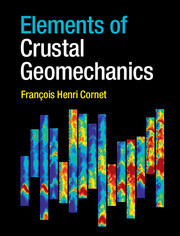Description
Elements of Crustal Geomechanics
Author: Cornet François Henri
A detailed introduction to the study of crustal geomechanics, particularly the seismogenic crust, with exercises, solutions, and field-based datasets.
Language: English
Subjects for Elements of Crustal Geomechanics:
Approximative price 74.82 €
In Print (Delivery period: 14 days).
Add to cart
Publication date: 04-2015
490 p. · 19.6x25.3 cm · Hardback
490 p. · 19.6x25.3 cm · Hardback
Description
/li>Contents
/li>Biography
/li>
This key textbook considers the mechanics of geomaterials at a wide range of scales, both in time and space. It provides a detailed introduction to the study of crustal geomechanics, focussing specifically on the seismogenic crust. The author demonstrates how continuum mechanics principles can provide efficient solutions to geomechanics problems at various scales, taking into account the multiphase characteristics of the geomaterials as well as discontinuities such as fractures and faults. Field and laboratory observations are combined with basic mathematical theory to build solutions with known levels of uncertainty. Particular consideration is given to the use of microseismicity. Case studies are provided, and practical results from numerical modelling are used to illustrate the applicability and limitations of current theories. Accessible explanations of mathematical formulations, convenient summaries of the key equations, and exercises make this a valuable reference for students and researchers in geomechanics, geophysics, structural geology and engineering.
Preface; 1. Geomaterials and crustal geomechanics; 2. Elements of rheology; 3. Forces and stresses; 4. Elements of kinematics; 5. Elements of linear elasticity; 6. From continuum mechanics to fluid mechanics; 7. Elements of linear fracture mechanics; 8. Laboratory investigations on geomaterials under compression; 9. Homogenized geomaterials; 10. Fractures and faults; 11. Elements of seismology; 12. Elements of solid-fluid interactions; 13. Methods for stress fields evaluation from in situ observations; 14. Elements of stress fields and crustal rheology; References; Appendix A. Elements of tensors in rectangular coordinates; Index.
François Henri Cornet is a Professor at the Institut de Physique du Globe de Strasbourg. Prior to this he worked in the Department of Seismology at the Institut de Physique du Globe de Paris, and was also Visiting Scientist at Stanford University and at The Lawrence Berkeley National Laboratory. His main research interests are in rock mechanics – specialising in measurement and modelling of stress fields; in rock-fluid interactions, including induced seismicity and application to geothermal energy development; and in the development of large scale, in situ, geophysical laboratories. Professor Cornet has extensive experience of teaching geomechanics courses at the undergraduate and graduate level, and has also consulted internationally on stress field evaluations.
© 2024 LAVOISIER S.A.S.

